
Oatlands is an important historical village on the shores of Lake Dulverton in the centre of Tasmania, Australia. Oatlands is located 84 km north of Hobart and 115 km south of Launceston on the Midland Highway. At the 2021 census, Oatlands had a population of 728.

Frenchmans Cap is a mountain in the West Coast region of Tasmania, Australia. The mountain is situated in the Franklin-Gordon Wild Rivers National Park.

Thomas Bock was an English-Australian artist and an early adopter of photography in Australia. Born in England he was sentenced to transportation in 1823. After gaining his freedom he set himself up as one of Australia's first professional artists and became well known for his portraits of colonists. As early as 1843 he began taking daguerreotypes in Hobart and became one of the earliest commercial photographers in Australia.

Carrick is a small historic village 17 kilometres (11 mi) west of Launceston, Tasmania, Australia, on the banks of the Liffey River. The Meander Valley Highway passes through the town's centre; this road was formerly the main road from Launceston to Deloraine and Devonport. Carrick has a well-preserved 19th-century heritage; fifteen of its colonial buildings are listed on the Tasmanian Heritage Register including Carrick House (1840), St Andrew's Church (1848), the Old Watch house (1837), Monds Roller Mill (1846) and the Carrick Hotel (1833).
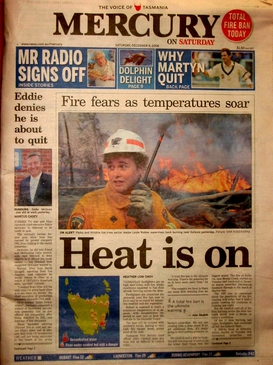
TheMercury is a daily newspaper, published in Hobart, Tasmania, Australia, by Davies Brothers Pty Ltd, a subsidiary of News Corp Australia, itself a subsidiary of News Corp. The weekend issues of the paper are called Mercury on Saturday and Sunday Tasmanian. The current editor of TheMercury is Craig Herbert.
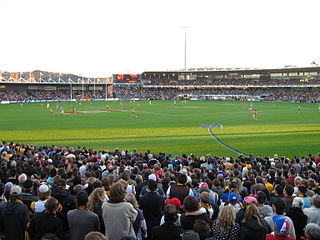
Australian rules football has been played in Tasmania since the late 1860s. It draws the largest audience for any football code in the state. A 2018 study of internet traffic showed that 79% of Tasmanians are interested in Australian rules football, the highest rate in the country.

The Tasmanian emu is an extinct subspecies of emu. It was found in Tasmania, where it had become isolated during the Late Pleistocene. As opposed to the other insular emu taxa, the King Island emu and the Kangaroo Island emu, the population on Tasmania was sizable, meaning that there were no marked effects of small population size as in the other two isolates.

The Stacks Bluff is a peak in northeast Tasmania, Australia. The mountain is situated on the Ben Lomond plateau.
The Courier is a newspaper founded in 1827 in Hobart, Tasmania, as The Hobart Town Courier. It changed its name to The Hobart Town Courier and Van Diemen's Land Advertiser in 1839, settling on The Courier in 1840.
George Quinlan Roberts was a Tasmanian-born rower who won events at Henley Royal Regatta in the 1880s. He later served as chief secretary of St Thomas' Hospital in London from 1903 to 1928.
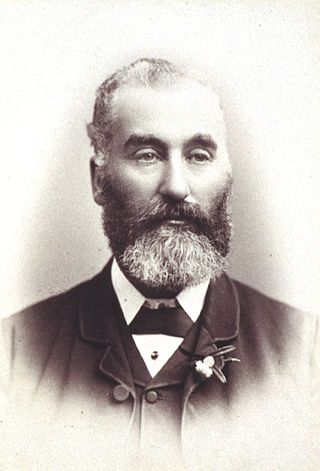
Sir John George Davies, generally known as (Sir) George Davies, was a Tasmanian politician, newspaper proprietor and first-class cricketer.

The Oatlands railway line was a short branch of the Main Line from Launceston to Hobart in Tasmania, which was built to give rail access to the town of Oatlands. The railway opened on 13 May 1885 and it closed on 10 June 1949. The line branched off of the Main Line in Parattah outside the Tudor style Parattah Hotel and followed parallel to the Main Line for approximately 700 metres (2,300 ft) before branching off in a north west direction towards Lake Dulverton. From there, the railway followed the lake's shoreline before turning in on Wellington Street and ending where it intersects with High Street. The original station building is now used as a child care centre. Much of the former route is now used as a bike trail, a section of it is clearly visible as a terrace like formation at Mahers Point and part of an embankment and small bridge runs alongside the road to Parattah, where it crosses Parattah Creek. The locomotive "Big Ben" used to operate the line from 1948 until the line closed a year later in 1949.
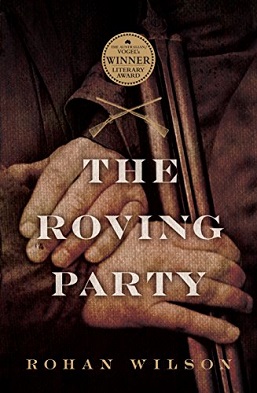
The Roving Party is a 2011 novel written by Tasmanian author Rohan Wilson. Wilson's first book, it is published by Allen & Unwin. The Roving Party won the 2011 Vogel Award. The novel was also shortlisted for the 2011 Victorian Premier's Literary Awards Vance Palmer Prize for Fiction.

Henry Hunter (1832–1892) was a prominent architect and civil servant in Tasmania and Queensland, Australia. He is best known for his work on churches. During his life was also at various times a state magistrate of Tasmania, a member of the Tasmanian State Board of Education, the Hobart Board of Health, a Commissioner for the New Norfolk Insane Asylum and President of the Queensland Institute of Architects.
The Tasmanian Heritage Register is the statutory heritage register of the Australian state of Tasmania. It is defined as a list of areas currently identified as having historic cultural heritage importance to Tasmania as a whole. The Register is kept by the Tasmanian Heritage Council within the meaning of the Tasmanian Historic Cultural Heritage Act 1995. It encompasses in addition the Heritage Register of the Tasmanian branch of the National Trust of Australia, which was merged into the Tasmanian Heritage Register. The enforcement of the heritage's requirements is managed by Heritage Tasmania.

Ingle Hall is a landmark building in Hobart, Tasmania on the corner of Macquarie and Argyle Streets. It has served numerous purposes over its history and is vacant; it was most recently used as The Mercury print museum. It is unknown when the building was built as it predates any government record holding by the state of Tasmania, which began in 1822. It is named for John Ingle, one of the two possible first inhabitants of the building.

Isle of the Dead is an island, about 1 hectare in area, adjacent to Port Arthur, Tasmania, Australia. It is historically significant since it retains an Aboriginal coastal shell midden, one of the first recorded sea-level benchmarks, and one of the few preserved Australian convict-period burial grounds. The Isle of the Dead occupies part of the Port Arthur Historic Site, is part of Australian Convict Sites and is listed as a World Heritage Property because it represents convictism in the era of British colonisation.
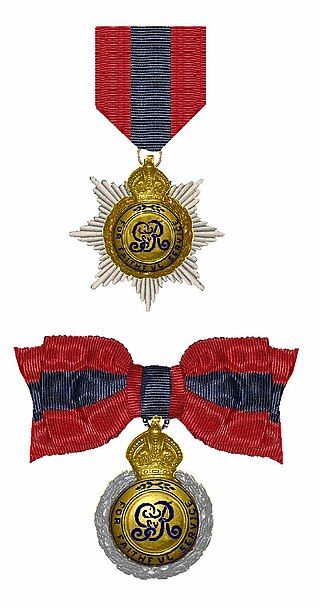
William Nevin Tatlow Hurst, ISO was a senior Tasmanian civil servant. In 1925 he succeeded the Tasmanian Surveyor-General, E A Counsel, as the head of the Tasmanian Department of Lands and Surveys, although with the title of Secretary for Lands.

Risdon Zinc Works is a major zinc refinery located in Lutana, a suburb of Hobart, Tasmania, Australia. The smelter is one of the world's largest in terms of production volume, producing over 280,000 tonnes annually of high-grade zinc, primarily as die-cast alloys and continuous galvanising-grade alloys. These products are exported for global markets and utilised in a wide range of industries and products, from building and infrastructure to transportation, business equipment, communications, electronics, and consumer goods. The facility produces zinc using the Roast, Leach, Electrowinning (RLE) method, creating leach byproducts, including cadmium, gypsum, copper sulphate, lead sulphate, sulphuric acid, paragoethite and leach concentrate. The refinery has been owned and operated by the global multi-metals business Nyrstar since 2007. Nyrstar Hobart works closely with the Nyrstar Port Pirie multi-metals smelter in South Australia. The facility is Tasmania's largest exporter, contributing 25% of the state's overall export value in 2013.
Mary Elizabeth Livingston was a late-colonial Australian artist. She was best known as a botanical artist, specialising in Tasmanian native flora.


























